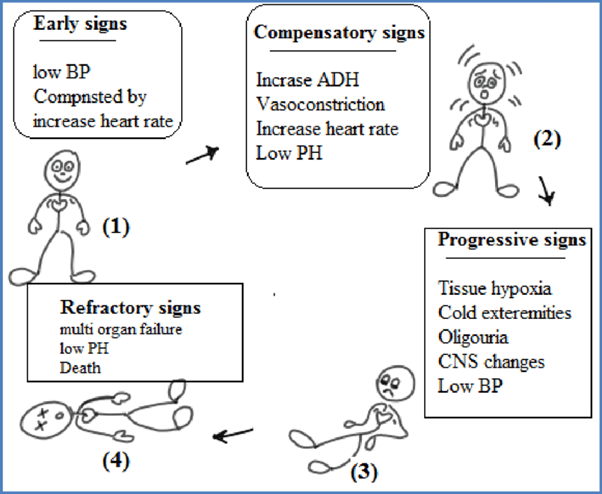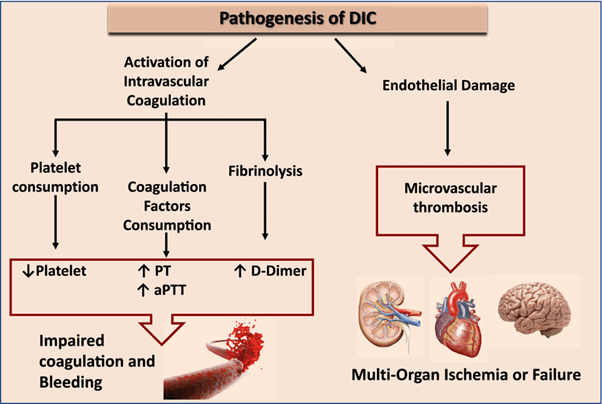The ICU nurse provides care for a 67-year-old female patient experiencing a distributive shock. Assessment findings are indicative of decreasing cardiac output, decreased peripheral perfusion, and increased capillary permeability. The nurse identifies that the patient is in which stage of shock.
Progressive stage
Compensatory stage
Initial stage
Refractory stage
The Correct Answer is A
The stages of shock are commonly described as the initial, compensatory, progressive, and refractory stages. Here is an explanation of each stage and why the patient's assessment findings correspond to the progressive stage:
B. The compensatory stage in (option B) is incorrect because, In the compensatory stage, the body continues to activate compensatory mechanisms to maintain perfusion. This includes increased heart rate, peripheral vasoconstriction, and shunting of blood to vital organs. The patient's assessment findings of decreasing cardiac output, decreased peripheral perfusion, and increased capillary permeability suggest that the body's compensatory mechanisms are no longer sufficient to maintain perfusion adequately. Therefore, the patient has progressed beyond the compensatory stage.
C. The initial stage in (option C) is incorrect because, In the initial stage, there is an initial insult or injury that triggers the shock state. The body's compensatory mechanisms are activated, such as increased heart rate and vasoconstriction, to maintain blood pressure and perfusion. However, the patient's assessment findings indicate that they have progressed beyond the initial stage.
D. The refractory stage in (option D) is incorrect because The refractory stage represents a severe and irreversible state of shock where vital organs fail, and despite interventions, the patient's condition does not improve. The patient's assessment findings do not suggest the refractory stage, as there is still potential for intervention and management.

Nursing Test Bank
Naxlex Comprehensive Predictor Exams
Related Questions
Correct Answer is B
Explanation
In this scenario, the patient's signs and symptoms suggest a state of shock, which can be caused by various factors, such as hypovolemia, cardiac dysfunction, or systemic vasodilation. The first priority in managing a patient in shock is to ensure adequate oxygenation and tissue perfusion. Administering oxygen at 100% per non-rebreather mask helps improve oxygen delivery to the tissues and supports vital organ function.
A. Placing the patient on a continuous cardiac monitor in (option A) is incorrect because it is an important step to monitor the patient's heart rhythm and identify any abnormalities. However, providing oxygen should take priority to address the potential hypoxemia and tissue hypoperfusion.
C. Inserting two 14-gauge IV catheters in (option C) is incorrect because it is crucial for establishing large-bore access for fluid resuscitation and medication administration. While it is an important step, addressing oxygenation takes precedence.
D. Drawing blood to type and crossmatch for transfusions in (option D) is incorrect because it is an important step in managing a patient in shock who may require blood products. However, ensuring adequate oxygenation through oxygen administration is the immediate priority.
Therefore, the nurse should act first on the order to administer oxygen at 100% per non-rebreather mask to support the patient's oxygenation and tissue perfusion.
Correct Answer is A
Explanation
Disseminated intravascular coagulation (DIC) is a condition characterized by both widespread activation of the coagulation system and excessive clotting, leading to the consumption of clotting factors and platelets. This results in a prothrombotic state, which can lead to organ dysfunction and bleeding manifestations.
Elevated D-dimer levels are a characteristic finding in DIC. D-dimer is a fibrin degradation product that is elevated when there is excessive fibrin formation and breakdown. Elevated D-dimer indicates ongoing fibrinolysis and activation of the clotting system.
B. Decreased prothrombin time in (option B) is incorrect because: DIC is characterized by consumption of clotting factors, which can result in prolongation of the prothrombin time (PT) as well as other coagulation tests.
C. Decreased partial thromboplastin time in (option C) is incorrect because Similar to the prothrombin time, the partial thromboplastin time (PTT) can also be prolonged in DIC due to the consumption of clotting factors.
D. Elevated fibrinogen level in (option D) is incorrect because, In DIC, there is consumption of fibrinogen along with other clotting factors. Therefore, elevated fibrinogen levels are not consistent with the pathophysiology of DIC.

Whether you are a student looking to ace your exams or a practicing nurse seeking to enhance your expertise , our nursing education contents will empower you with the confidence and competence to make a difference in the lives of patients and become a respected leader in the healthcare field.
Visit Naxlex, invest in your future and unlock endless possibilities with our unparalleled nursing education contents today
Report Wrong Answer on the Current Question
Do you disagree with the answer? If yes, what is your expected answer? Explain.
Kindly be descriptive with the issue you are facing.
